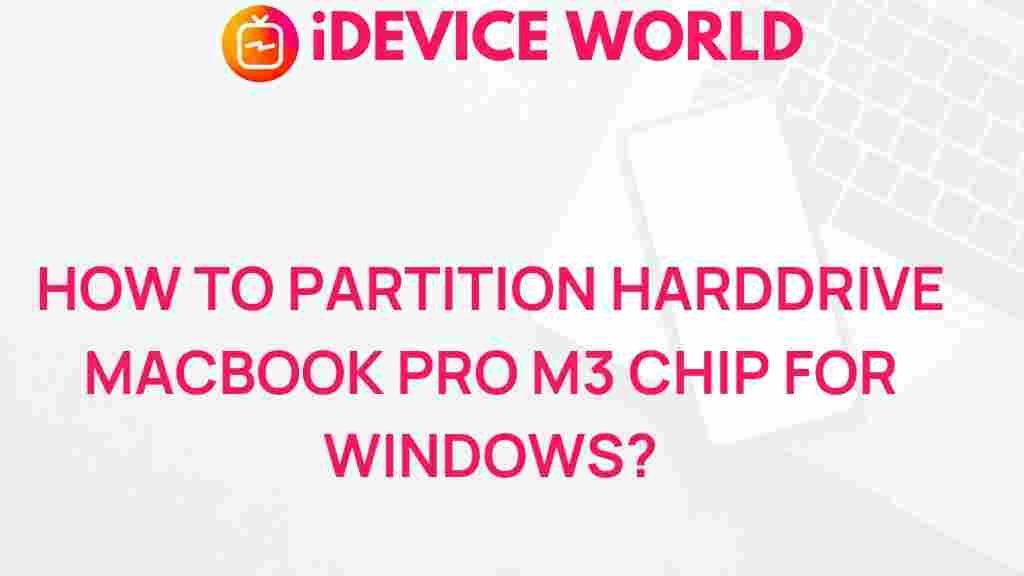Unleashing the Power of Macbook Pro M3 Chip
The Macbook Pro M3 Chip represents a significant leap in performance and efficiency for Apple’s laptops. With its powerful architecture, the M3 chip enhances productivity and creative tasks, making it a popular choice among professionals and enthusiasts alike. However, with its advanced capabilities, many users are eager to explore the possibilities of running Windows on their Macbooks. This guide will delve into partitioning your hard drive, allowing you to install and run Windows alongside macOS effectively.
Why Partition Your Hard Drive?
Partitioning your hard drive offers several advantages, especially when using a Macbook Pro M3 Chip:
- Run Windows Natively: Gain access to Windows-exclusive software and applications.
- Improved Performance: A dedicated partition allows Windows to utilize hardware resources more efficiently.
- Flexibility: Easily switch between macOS and Windows for various tasks.
- Increased Storage Management: Helps keep files organized by separating operating systems and applications.
Step-by-Step Guide to Partitioning Your Hard Drive
Prerequisites
Before you begin, ensure you have the following:
- A Macbook Pro M3 Chip with sufficient storage space.
- A USB drive (at least 16GB) for the Windows installation media.
- Access to a Windows ISO file.
- Backup of important data.
1. Backup Your Data
It’s crucial to backup all important files before partitioning your hard drive. You can use Time Machine or any other backup software to ensure your data is safe.
2. Create a Bootable USB Drive
To install Windows, you will need to create a bootable USB drive. Follow these steps:
- Download the Windows ISO file from the official Microsoft website here.
- Insert your USB drive into your Macbook.
- Open the Terminal application.
- Use the following command to create a bootable USB drive (replace “WIN_ISO_PATH” and “USB_DRIVE_NAME” with your actual paths):
sudo dd if=WIN_ISO_PATH of=/dev/USB_DRIVE_NAME bs=1m
3. Access Disk Utility
Next, you need to access Disk Utility to partition your hard drive:
- Open Disk Utility from the Utilities folder.
- Select your main hard drive (typically named “Macintosh HD”).
- Click on the “Partition” button.
4. Partition Your Hard Drive
Now, it’s time to create a new partition for Windows:
- In the partition section, click the “+” button to add a new partition.
- Set the size of the partition (at least 50GB is recommended for Windows).
- Name the partition (e.g., “Windows”).
- Select “MS-DOS (FAT)” as the format.
- Click “Apply” to create the new partition.
5. Install Windows Using Boot Camp
With your hard drive partitioned, you can now proceed with the installation of Windows:
- Open the Boot Camp Assistant (found in the Utilities folder).
- Follow the on-screen instructions to proceed with the installation.
- When prompted, select the partition you created for Windows.
- Choose your USB drive as the installation source.
- Complete the installation process by following the prompts.
6. Complete Windows Setup
After the installation, Windows will prompt you to complete the setup. Ensure you have an internet connection for any necessary updates.
Troubleshooting Tips
While installing Windows on a Macbook Pro M3 Chip is generally straightforward, issues may arise. Here are some troubleshooting tips:
- Installation Fails: Ensure that your USB drive is formatted correctly and the Windows ISO file is not corrupted.
- Boot Issues: If Windows doesn’t boot, hold down the Option key during startup to select the correct partition.
- Performance Problems: Check for any software updates for both macOS and Windows, and ensure drivers are installed correctly.
Conclusion
The Macbook Pro M3 Chip allows users to harness the power of both macOS and Windows through effective hard drive partitioning. By following the steps outlined in this guide, you can easily set up a dual-boot system that caters to all your computing needs. Whether for work or play, the combination of these operating systems opens up a world of possibilities.
For more tips on optimizing your Mac, check out our comprehensive guide on Macbook enhancements. Happy computing!
This article is in the category Guides & Tutorials and created by iDeciveWorld Team
